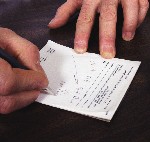 |
Q: My state allows optometrists to prescribe oral narcotic analgesics for the treatment of ocular pain. I havent yet applied for a Drug Enforcement Administration (DEA) number because Im concerned about prescribing controlled substances and treating patients in pain.
A: Be aware that other doctors arent necessarily better judges at evaluating and managing patients pain. Indeed, many studies have shown that all types of doctors often underestimate their patients pain and discomfort.1,2
How can you avoid this? Talk to the patient. We should manage pain and discomfort at the level that the patient reports it, not on our feelings of what it should be, says Bruce Onofrey, R.Ph., O.D., who has a large HMO practice in Albuquerque, N.M.
Some patients have a high tolerance for pain; others dont. Everything depends upon the patients perception of pain, and the only way to get that information is to ask them, Dr. Onofrey says.
 |
| For an Rx for narcotics, write out in longhand the number of tablets. |
To quantify the amount of pain, ask patients to grade the pain on a zero to 10 scale. If they say its a pain greater than six, then theyre in significant discomfort, and that can be managed, he says.
But management of the pain depends on the diagnosis. For example, narcotics can relieve eye pain from a corneal injury or from a procedure such as foreign body removal, Dr. Onofrey says. But, narcotics dont adequately relieve pain from herpes zoster, such as shingles. Neurontin (gabapentin, Pfizer) is much more appropriate and effective for post-herpetic neuralgia, he says.
Bear in mind that relief of pain is not an endpoint in management. Pain is not a disease, its a symptom, Dr. Onofrey says. You dont treat pain. You treat the reason for the pain.
So, work up the patient to find the reason for the pain (uveitis, for example). Treat that diagnosis, then manage the pain secondary to that primary diagnosis, he says.
If you cant determine the cause of the pain, or if the cause is not eye-related or in your scope of care, then comanage the patient with another clinician who can, he says.
Q: Should I get a DEA number even if I decide not to prescribe controlled substances?
A: The Drug Enforcement Administration issues numbers to doctors to regulate abuse of controlled substances, Dr. Onofrey says. Theres no point in acquiring DEA registration other than to prescribe these drugs. (The issue of using DEA numbers to track who is or who isnt writing prescriptions is not what a DEA number is for, he says.)
Heres my take on this: If your state law allows you to prescribe narcotics, as it does in my state of Georgia, I encourage you to apply for a DEA number. Even if you dont use it a lot, youll have it when you need it.
To that end, there are a number of precautions to consider should you acquire a DEA number:
Dont print your DEA number on your prescription pad, Dr. Onofrey says. He prefers to call the prescription into the pharmacy and provide his DEA number over the phone.
If you do give the patient a written prescription with your DEA number, write out in longhand the number of tablets, he says. Dont use numerals, as the addition of a zero could turn an Rx for 24 tablets into 240.
Always write Zero refills, and be alert for any behaviors that suggest the patient may be abusing the drug, Dr. Onofrey says.
(For more on this topic, see Understand and Control Your Patients Pain.)
1. Luger TJ, Lederer W, Gassner M, et al. Acute pain is underassessed in out-of-hospital emergencies. Acad Emerg Med 2003 Jun;10(6):627-32.
2. Marquie L, Raufaste E, Lauque D, et al. Pain rating by patients and physicians: evidence of systematic pain miscalibration. Pain 2003 Apr;102(3):289-96.

